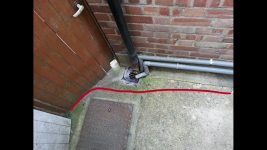I can't speak to UK electrical codes, but I *can* make some universal observations. Some of them may not be valid depending on the size and intended use of your shed, but I'll tell you what I did for my shop (not a shed).
1. Put in a larger feed wire than you think you need or want. The price of copper (or aluminum) NOW is dirt cheap compared to wishing you had gone bigger later. I have never heard anyone say "I wish I didn't have so much power available to me!"
2. There is generally a 'sweet spot' that makes the most sense, i.e. best 'bang for the buck'. Here in the US it's either 60 or 100 Amps, so in the UK I'd guess it's around half of that since your voltage is double ours. (Same power level but half the current.)
3. If your feeder is in conduit or is otherwise shielded, drop in TWO runs of cat 6 underground cable and at least one RG6 ( or the metric equivalent [wink]) for television. If it's not metallically shielded, put some dirt over the power lines (do a little backfill first) to provide physical isolation between the power lines and the signal/low-voltage lines. I'm assuming that you can bury both in the same trench, but you'd need to verify that. (My electrical is 30-32" below the surface; low voltage stuff is ~6" above that).
4. Consider dropping in a PVC conduit (assuming that's legal and available in the UK) or a second run of whatever is legal. Pull in a nylon line to use for pulling wires later. Like your feeder line, make it bigger than you think you will need.
5. Assuming you do as much of the work as you can (trenching, laying conduit, backfilling, etc.) the cost from your electrician is not going to change much based on the size of the feeder or the size of the conduit. If you ever need to re-do it, however, the cost will be STAGGERING!
For reference, my shop is about 150 feet from my house. It has it's own 200 Amp electrical panel, as well as some direct buried video and control cables. It *also* has TWO 2" PVC conduits connecting it to the house, in which I have multiple Cat 6 and RG6 and low voltage control cables running. I feed TV signals TO the shop from the house, and security video FROM the shop to the house. I control my overhead door and HVAC over WiFi. I have heat sensing fire alarms (not smoke alarms, since I weld out there) in the shop that are connected to one in the house, so should a fire start out there I know about it right away. I am immediately alerted to motion or other activity in the shop via my alarm system over low voltage wiring. I can observe the security cameras over the internet, and - as a backup - through the buried cable which is not easy to cut or interrupt like WiFi could be.
None of this was insanely expensive, and your run is much shorter than mine. Sounds like your electrical contractor rates are MUCH higher, though?
BTW, I didn't get this all right the first time. I put in the 200 amp service initially, since I always intended to use lots of power tools in there. But I added the direct buried cables later, and the conduit even later than that. Both of those times required me to pretty much hand-dig the trench because I had other wires in the ground that prevented the use of earth-moving equipment. So learn from my mistakes and do it all now.
[big grin]


